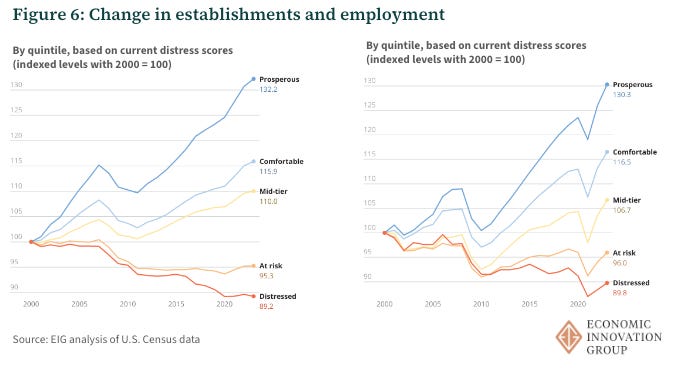Originally published on Agglomerations, the Substack newsletter from the Economic Innovation Group.
By Kenan Fikri and Sarah Eckhardt
The United States is riding high on a long period of exceptional economic growth. American affluence and dynamism remain the envy of the world. Yet huge place-based disparities linger under the surface.
Where you live determines whether you experience that growth first-hand, or sit it out instead.
Where you live also affects how long you live, predicting longevity with uncanny reliability.
Put simply: Your ZIP code isn’t just for delivering the mail. It’s a summary statistic for your life. And it largely determines whether you’re part of the nation’s exceptional economic story — or one of the exceptions to it.
That’s the inescapable conclusion from our latest foray into the Distressed Communities Index (DCI).[1]
Let’s jump in.
Suburbia: Where prosperity reigns supreme
Levittown, NY, lays claim to being the nation’s first modern suburb.[2] Built in 1947, it pioneered a form of human settlement that would expand with the nation and characterize the American century.
To this day, Levittown remains one of the most prosperous ZIP codes (11756) in the country, landing in the top quintile on the DCI.[3] Its lasting reign reflects the enduring hegemony of the suburbs in American economic life.
Nationally, the country’s population is evenly divided between urban, semi-urban (which we’ll call suburban[4]), and rural areas. Fully 55 percent of the population in top-tier ZIP codes live at suburban densities, compared to only 20 percent in the bottom (distressed) tier.
Put differently, fully 64 percent of the U.S. population living at semi-urban densities reside in prosperous or comfortable zip codes (Figure 2). That is far and above the 36 percent in rural areas or 38 percent in urban ones.
Suburban areas have also kept many of the economic challenges facing other types of communities at bay. Less than 10 percent of suburbanites live in a distressed zip code, half the share of their rural or urban neighbors.
Zoned out
Suburbs are living testaments to the social and economic power of zoning, and zoning decisions past and present continue to affect who resides in the country’s most prosperous communities. Two groups in particular are underrepresented in places in the top tier of American well-being: young people and minorities.
Nationally, the U.S. Census Bureau classifies 58 percent of the population as non-Hispanic white. In top-tier prosperous communities, that figure rises to 70 percent. In distressed communities, the white share falls to 42 percent.
The disparities become starker if you look at the distribution of each group’s population across DCI quintiles. A plurality of whites and Asians live in prosperous zip codes, and more than half live in prosperous or comfortable ones. By contrast, a plurality of Hispanics live in at-risk zip codes, and a plurality of Blacks and Native Americans live in distressed ones.[5]
The economy looks very different in distressed ZIP codes. On average, more than one in five residents lives in poverty in these communities. The median local household earns nearly $30,000 less annually than the median household nationally. One in seven homes is vacant or abandoned, one-third of prime age adults are not working, jobs are disappearing, and businesses are closing even as the national economy booms.[6]
Children and young adults are disproportionately exposed to these adverse neighborhood conditions. Young adults in particular are overrepresented in distressed communities and underrepresented in burgeoning prosperous ones relative to other age groups.
Nationally, 45 percent of the population is under the age of 35, but in distressed zip codes, that figure rises to 48 percent — compared to 43 percent in prosperous communities. Young people under the age of 35 account for a full 5 percentage point greater share of the population in the country’s most struggling neighborhoods than they do in its best off ones.

By no means are a majority or even a plurality of young people exposed to truly adverse neighborhood conditions. Outright distressed zip codes contain the smallest slice of every age group (see Figure 5).
But young people’s greater relative exposure to distressed neighborhoods — especially the very youngest children in the 0–5 bracket — matters because life trajectories are most malleable in youth. Neighborhood conditions shape a whole range of lifetime outcomes for children, even impacting their credit scores as adults.[7]The impact on young adults is less clear, but residing in disproportionately distressed neighborhoods is likely to affect behaviors, outlooks, and opportunity sets in myriad ways.
To an extent, these generational differences reflect different stages of life. As people age and advance in their careers, many move to better neighborhoods. Those 35–59 year olds are overrepresented in prosperous zip codes in part because they are in their peak earning years.
But the long shadow of racial and ethnic segregation may be at work too. Younger generations are significantly more diverse than older generations, meaning race-based divides can also appear as age-based ones. The predominant housing stock on offer in prosperous suburbs — single-family homes — does not meet the needs of many young adults.
To be sure, many suburbs at the top of the DCI represent the epitome of the American Dream for people from all backgrounds. More people live in top-tier communities than any other. But access to the best and most opportunity-rich communities the nation has to offer remains deeply unequal.
And just how opportunity rich they are
Prosperous communities power U.S. economic growth. They have generated 60 percent of the nation’s job and business growth in the 21st century with less than 40 percent of the nation’s population.
Two of the seven component indicators of the DCI capture growth over the most recent five-year period (for jobs and business establishments). But looking back from today all the way to 2000, it becomes very clear that growth begets growth — a key ingredient in prosperous areas’ success.
Figure 6 traces the growth trajectories for counties in each quintile on the DCI today.[8] Today’s prosperous counties have 30 percent more jobs and 33 percent more businesses as a group than they did at the turn of the century, compared to 23 and 18 percent for the United States as a whole. Prosperous counties have enjoyed roughly double the growth rates of comfortable counties and triple the growth of mid-tier ones. This roughly tracks their advantage in population growth, as well. The counties that won the pandemic recovery are by and large the same counties that won the recovery from the Great Recession and the recovery from the dot-com bust before that.

Distressed and at risk counties have experienced a very different quarter century. They shared near-complete stagnation in the early 2000s and again in the wake of the Great Recession. They barely participated in the post-COVID bounce. Only slight differences in magnitude differentiate the two groups: Distressed counties have lost slightly more than 10 percent of the jobs and businesses they had in 2000, while at-risk counties have lost roughly 5 percent.
Prosperous communities encapsulate the nation’s remarkable growth story, but the story only applies to a portion of the map.
The prosperity dividend: a half-decade more life
These local differences in economic well-being add up to major differences in non-economic outcomes, too — none more consequential than life expectancy.
County distress scores are strongly correlated with life expectancy. Residents of the average prosperous county live over five years longer (5.3 years to be exact) than those in the average distressed one, widening to 8 years in the top and bottom percentiles. Just in Virginia, residents of distressed Martinsville can expect to live to 68; their brethren in Arlington are likely to live to 85. Similar gradients exist across health indicators, from mental health to obesity rates.
Where one lives is by no means the sole determinant of one’s longevity, but it matters. It influences the pollution one is exposed to. It influences the quality of food one has access to. It influences the social behaviors one adopts.
People sort into different communities based on characteristics that also influence their health and longevity, of course. Place captures all that. And place is its own causal vector, too.
Conclusion
One’s ZIP code or county hardly trumps free will and individual agency in the United States today, but place subtly operates in the background of American life, influencing individual trajectories, shaping families, and seeding possibilities.
This post examined the nation’s most exceptional spaces, the ZIP codes and counties at the apex of national well-being. A quarter of the nation’s population — 83 million people — reside in one of these prosperous ZIP codes, nearly 32 million more than live in a distressed one. The vitality of these communities testifies to the awesome power of the U.S. economy.
Yet the gaps identified in the DCI also testify to the unfinished business of the American experiment: deep divides, divergent trends, and always the opportunity to do better.
The Distressed Communities Index (DCI) is EIG’s flagship data product exploring geographic inequality in the United States. To learn more about the DCI, explore the interactive map, or download the data for your own use, visit: eig.org/dci
And please check out EIG’s YouTube page to see our new videos about the DCI.
Notes
- For the uninitiated, the DCI ranks all U.S. ZIP codes (as well as counties, separately) on seven indicators of economic well-being and then groups them into five equal tiers ranging from prosperous to distressed.[↩]
- A case study in exclusionary zoning, it would also become a microcosm for the tensions at the heart of the American Dream.[↩]
- Here an honorable mention goes out to Levittown, PA (ZIP code 19055), in Bucks County, which is credited with being the nation’s second suburb (same developer, naturally) but now lands into the more modest “comfortable” quintile on the DCI.[↩]
- It also includes exurban and small town densities, or anything with a population density between 500 and 3,000 residents per square mile.[↩]
- Fully 41 percent of the Native Americans population resides in a distressed community, a greater share than any other racial or ethnic group.[↩]
- Based on the characteristics of the average zip code in the distressed quintile.[↩]
- See for example
Chetty, Raj, and Nathaniel Hendren. 2015. “The Impacts of Neighborhoods on Intergenerational Mobility: Childhood Exposure Effects and County-Level Estimates”
National Academies of Sciences, Engineering, and Medicine. 2024. Reducing Intergenerational Poverty
Leventhal T, Brooks-Gunn J. “The neighborhoods they live in: the effects of neighborhood residence on child and adolescent outcomes”[↩]
- Here we pivot to counties to maintain consistent geographic boundaries over time, but the overall results and trends are similar regardless of the geographic scale of analysis; zip codes and counties can be expected to have similar growth patterns over time when broken out by DCI quintiles, and the majority of prosperous zip codes are also located within prosperous counties.[↩]






